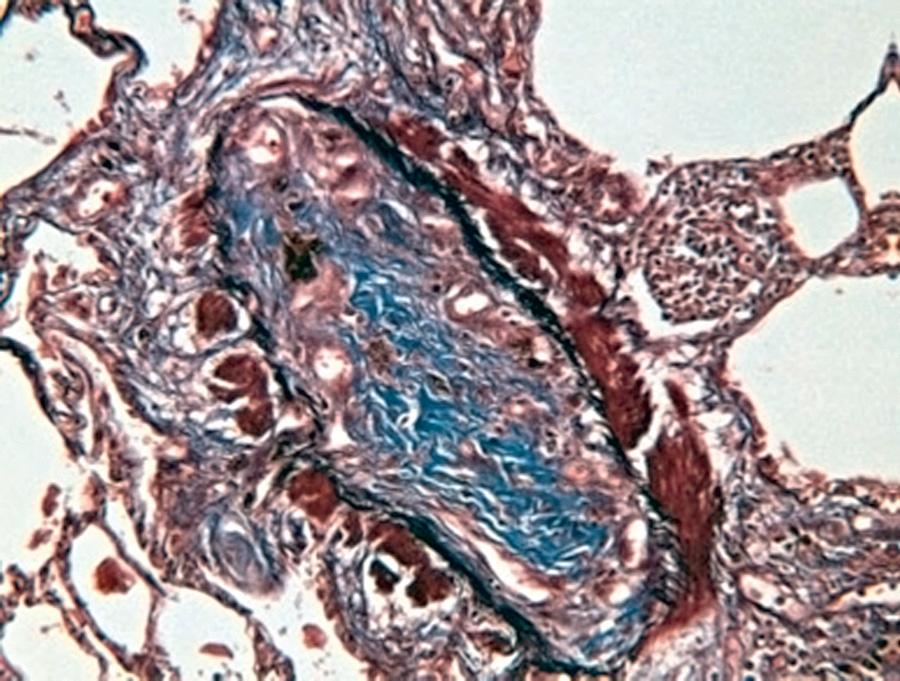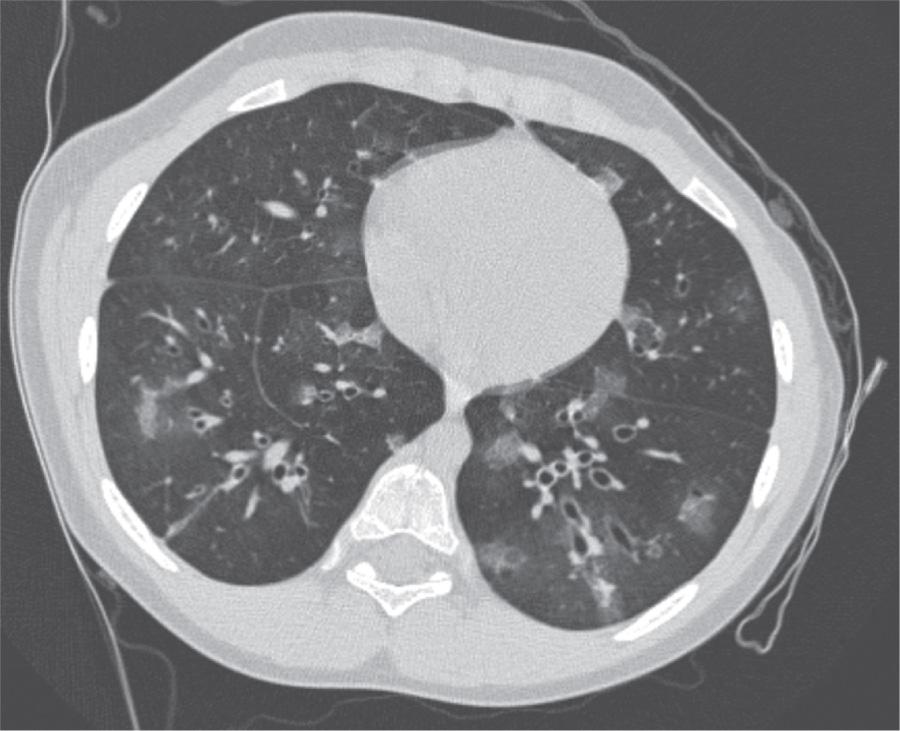Physical Address
304 North Cardinal St.
Dorchester Center, MA 02124
Bronchiolitis obliterans
Bronchiolitis obliterans syndrome
Bronchiolitis obliterans organizing pneumonia
Cryptogenic organizing pneumonia
Bronchiolitis obliterans (BO) is a histopathologic diagnosis characterized by chronic obstructive lung disease of the bronchioles and smaller airways, resulting from an insult to the lower respiratory tract leading to inflammation and fibrosis of the small airways. In the nontransplant patient, BO most commonly occurs in the pediatric population after respiratory infections, particularly adenovirus (see Chapter 289 ), but also Mycoplasma pneumoniae (see Chapter 250 ), measles (see Chapter 273 ), Legionella pneumophila (see Chapter 235 ), influenza (see Chapter 285 ), and pertussis (see Chapter 224 ); other causes include inflammatory diseases (juvenile idiopathic arthritis, systemic lupus erythematosus [see Chapter 183 ], scleroderma [see Chapter 185 ], Stevens-Johnson syndrome [see Chapter 177 ]), and inhalation of toxic fumes or particulate exposure (NO 2 , incinerator fly ash, NH 3 , diacetyl flavorings from microwave popcorn, papaverine, fiberglass) ( Table 422.1 ). Postinfection obliterans may be more common in the southern hemisphere and among persons of Asian descent. BO is also commonly seen in post lung or bone marrow transplant recipients.
| POSTINFECTION |
|
| POSTTRANSPLANTATION |
|
| CONNECTIVE TISSUE DISEASE |
|
| TOXIC FUME INHALATION |
|
| CHRONIC HYPERSENSITIVITY PNEUMONITIS |
|
| ASPIRATION |
|
| DRUGS |
|
| STEVENS-JOHNSON SYNDROME |
|
Bronchiolitis obliterans syndrome (BOS) is a clinical diagnosis related to graft deterioration after transplantation defined as a progressive decline in lung function based on FEV1. The airway obstruction is generally irreversible. BOS is considered once other causes of airway obstruction are excluded. BOS is recognized as a long-term complication of both lung and bone marrow transplantation with more than one third of survivors of lung transplantation developing this disorder. Risk factors for the development of BOS include the presence of CMV pneumonitis, aspergillus colonization, primary graft dysfunction, gastroesophageal reflux, and community-acquired respiratory viruses, as well as prolonged transplantation ischemic time.
After the initial insult, inflammation affecting terminal bronchioles, respiratory bronchioles, and alveolar ducts can result in the obliteration of the airway lumen ( Fig. 422.1 ). Epithelial damage resulting in abnormal repair is characteristic of BO. Complete or partial obstruction of the airway lumen can result in air trapping or atelectasis. Parenchymal involvement is not seen. Bronchiolitis obliterans organizing pneumonia (BOOP) or what has also been termed cryptogenic organizing pneumonia is a histopathologic diagnosis. Although it is similar to many of the histologic features of BO, BOOP is also characterized by extension of the inflammatory process from distal alveolar ducts into alveoli with proliferation of fibroblasts (parenchymal involvement).

Cough, fever, cyanosis, dyspnea, chest pain, and respiratory distress followed by initial improvement may be the initial signs of BO. In this phase, BO is easily confused with pneumonia, bronchitis, or bronchiolitis. Progression of the disease can ensue, with increasing dyspnea, chronic cough, sputum production, and wheezing. Physical examination findings are usually nonspecific and can include wheezing, hypoxemia, and crackles. Chest radiographs may be relatively normal compared with the extent of physical findings but can demonstrate hyperlucency and patchy infiltrates. Occasionally, a Swyer-James syndrome (unilateral hyperlucent lung; see Chapter 420 ) develops. Pulmonary function tests demonstrate variable findings but typically show signs of airway obstruction with a variable degree of bronchodilator response although more commonly irreversible. Exercise testing shows reduced exercise capacity and impaired oxygen consumption. Ventilation-perfusion scans reveal a typical moth-eaten appearance of multiple matched defects in ventilation and perfusion. High-resolution chest CT often demonstrates patchy areas or a mosaic pattern of hyperlucency, air trapping, and bronchiectasis ( Fig. 422.2 ). Table 422.2 provides an overview of CT findings of BO and related disorders. Physical and radiologic signs can wax and wane over weeks or months. Open lung biopsy or transbronchial biopsy remains the best means of establishing the diagnosis of BO or BOOP.

| STUDIES (N) | GROUND-GLASS OPACITY | THICK SEPTA | NODULES | MOSAIC PATTERN | HONEYCOMBING | |
|---|---|---|---|---|---|---|
| Bronchiolitis obliterans | 4 | — | — | — | X | — |
| Nonspecific interstitial pneumonitis | 6 | X | — | — | — | X |
| Desquamative interstitial pneumonitis | 4 | X | — | — | — | X |
| Follicular bronchitis or neuroendocrine cell hyperplasia of infancy | 4 | X | — | — | X | — |
| Lymphocytic interstitial pneumonitis | 4 | — | — | X | — | — |
| Lymphangiomatosis | 2 | — | X | — | — | — |
| Lymphangiectasia | 2 | — | X | — | — | — |
| Pulmonary alveolar proteinosis | 2 | X | X | — | — | — |
No definitive therapy exists for BO. Administration of corticosteroids may be beneficial. Immunomodulatory agents, such as sirolimus, tacrolimus, aerosolized cyclosporine, hydroxychloroquine, and macrolide antibiotics, have been used in post–lung transplantation recipients with BO with variable success. Supportive measures with oxygen, antibiotics for secondary infections, and bronchodilators are adjunct therapies. The role of gastroesophageal reflux and its association with BO has been raised, with treatment suggested whenever the diagnosis is made. Azithromycin may be effective in patients with BOS. For BOOP, use of oral corticosteroids for up to 1 yr has been advocated as first-line therapy for symptomatic and progressive disease. Patients with asymptomatic or nonprogressive BOOP can be observed.
Become a Clinical Tree membership for Full access and enjoy Unlimited articles
If you are a member. Log in here